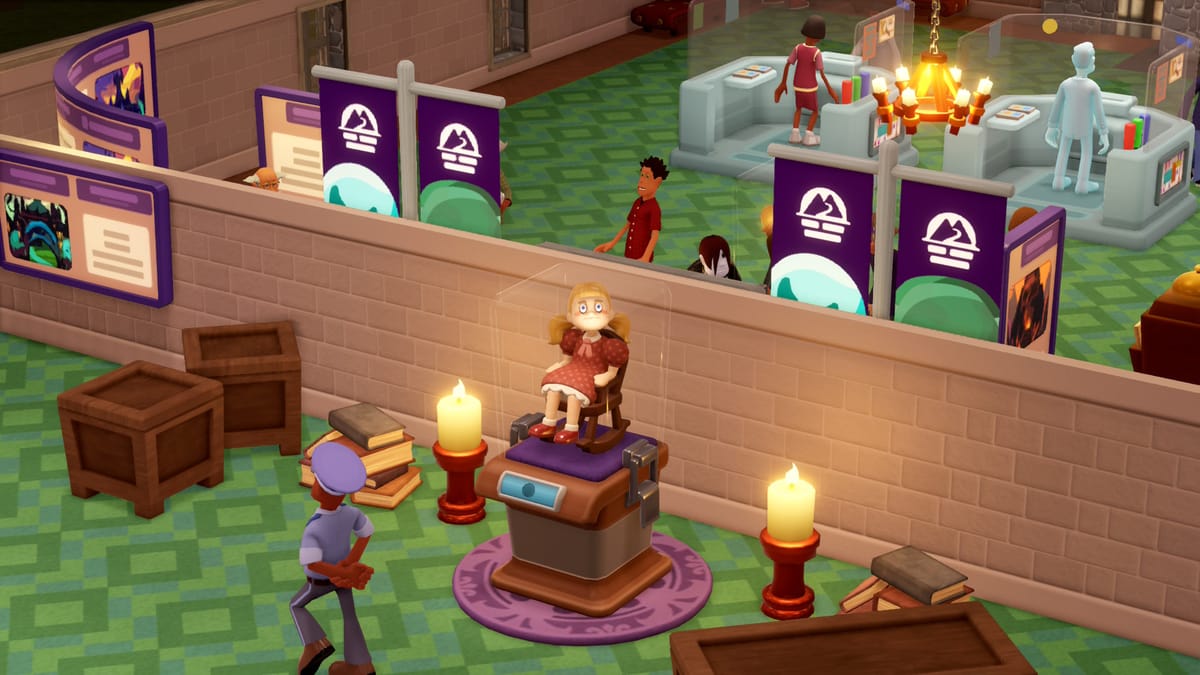
I love the Two Point series. They take the usually complex simulation genre, put a wacky twist on it, and make things simpler and more casual without removing any of the depth players expect. Whether you’re looking to optimize a hospital, university, or museum, create a fun facility, or just kill some time, you’re bound to enjoy at least some aspect of these three games. I played the previous two games, Two Point Hospital and Two Point Campus, on PC as these kinds of games generally work best with a mouse and keyboard. I missed out on Two Point Museum when it first launched on PC earlier this year, so it coming to the newest Nintendo console, the Switch 2, seemed like a great place to finally play it. I am happy with this version as it is, though it’s far from perfect.
First off, you’d think Switch 2 specific features would be great for a game like this. You get both the comfort and ease of a gamepad along with the utility of a touch screen or the Joy-Con 2’s mouse mode, but Two Point Museum doesn’t use either of these control methods as of writing. It’s the gamepad or bust. That’s pretty disappointing, and I hope they patch them in at some point in the future, but the stick and button controls work well enough. You pan with the left stick, rotate with the right, zoom with the triggers, and use the face buttons to interact with things or activate menus. Your cursor when not in a menu is always in the center of the screen, which makes pointing and clicking a breeze.
Navigating menus is a bit less intuitive, especially on UI elements with multiple sections and categories of buttons. For example, when clicking on a museum display, the game will open a panel showing the display’s stats (it’s cleanliness, buzz generated, etc.) focusing your cursor on a set of common interactions like picking up the display or sending a curator over to take care of it. This is fine, but the problem comes when you want to interact with the rest of the panel to attach things like perks or see a few more details. To do that, you need to press the Y button to swap focus even though that usually focuses you on your main menu in the bottom left corner. Sometimes you need to press B instead of Y though that’s always clearly denoted.
It can be difficult to tell what buttons do what and when, and it never feels like there’s a unifying control scheme to create commonality between different mechanics. The buttons you’ll use when sending staff on an expedition are completely different to those used when creating rooms or placing furniture. The only constant is that the A button is ‘confirm’.

That said, it’s not hard to get used to this, it’s just a little weird and more cumbersome than it could be. I still butted up against the control scheme a lot of the time, but I was having so much fun it was hard to care too much. Slowly seeing your museum come together over the in-game years is incredibly satisfying, and there are a bunch of different themed museums to oversee too, like prehistory, a haunted hotel, or classic fantasy. If you’re not too keen on managing money or sticking with a theme, there’s also a sandbox mode you can dive into for more freeform fun. It seems like this version also has DLC parity, I had access to the pre-order Sonic decoration bonus items, the Fantasy Finds DLC was already up at launch in addition to the Explorer Upgrade Pack, and the ongoing Vampire Survivors crossover is advertised in the news section of the main menu though I couldn’t figure out how to access it yet. It’s nice for a port to already be up to date on what the other versions enjoy, and it’s close enough to the original game’s launch on PC that I’m not too miffed the DLC isn’t included with the base game purchase.
Of course, none of that matters if the game doesn’t run well, and I have mostly good news on that front. The game is largely locked to 30 fps, but once your museum gets big enough or there’s a large amount of guests you’ll start to feel some stuttering, especially when panning the camera. It’s not a dealbreaker, but it is annoying and can make really filling out a museum feel less satisfying than it should. Just like the controls, hopefully this will be patched in the future. I don’t necessarily need 60 fps or higher for a title like this, but I would like a more stable experience.

The real reason to choose the Switch 2 version over PC or another, more powerful console is portability, and I am definitely willing to sacrifice some bells and whistles for that. Chipping away at a museum whenever you have a few free minutes is nice, but the initial load times are so long you’ll have to keep the game running in sleep mode to do that. It’s not ideal, but again something I’m willing to put up with for portability, and I think that sums up this port nicely.
